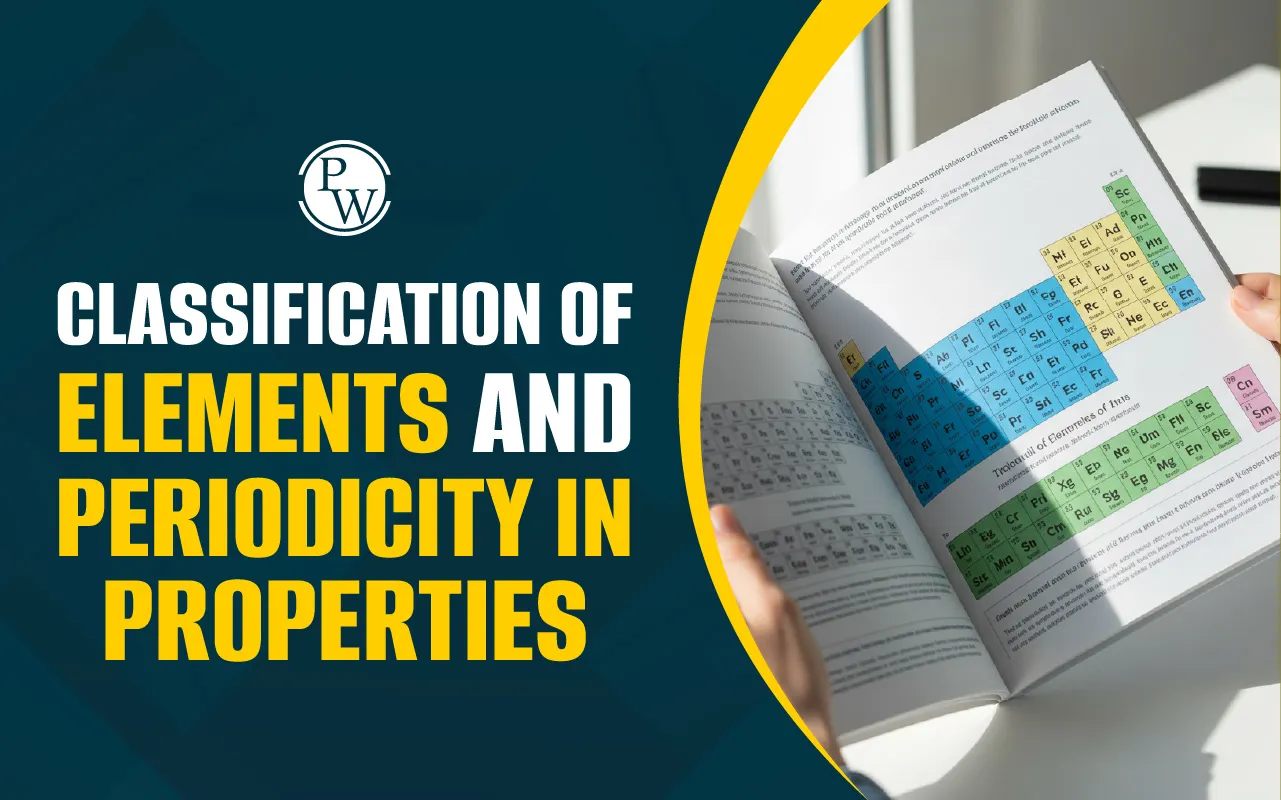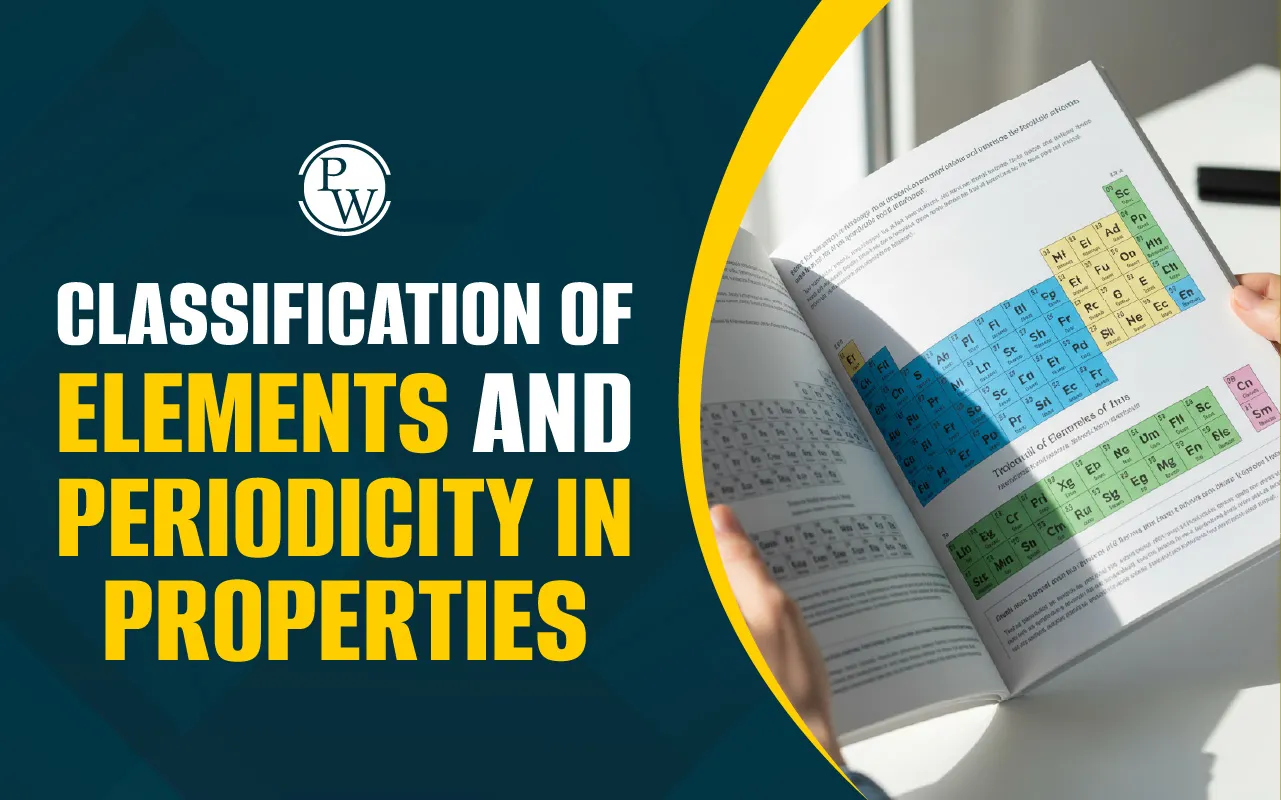

Classification of Elements and Periodicity in Properties: Everything around us in our surroundings is made up of basic building blocks called the elements. It includes the air we breathe to the water we drink, and our own bodies. There are over a hundred of these elements. Scientists have arranged these elements into a giant, organised chart called the Periodic Table to study the properties of these elements.
Classification of Elements and Periodicity in Properties is organised so that elements with similar behaviours are grouped. This orderly arrangement is called the Classification of Elements. We will learn about some special properties and the trends they follow.
Elements and Their Classifications Overview
An element is a pure substance that cannot be broken down into simpler substances by ordinary chemical means. Take, for example of Gold, Oxygen and Carbon. Each is an element.
-
All matter is made up of atoms. All the atoms of a single element are nearly identical.
-
The process of grouping elements with similar characteristics together is called the Classification of Elements. This classification helps scientists predict the behaviour, reactions, and uses of elements.
-
Periodicity refers to the repeating at regular intervals. Periodicity in Properties is the repeating pattern of certain properties of elements when arranged in the periodic table.
-
The earliest successful Periodic Table was created by Dmitri Mendeleev. He arranged elements based on their atomic mass and repeating chemical behaviours. The modern table arranges them by atomic number.
Classification of Elements and Periodicity in Properties Study Material PDF
Classification of Elements and Periodicity in Properties are important concepts from which questions are asked in various examinations every year. The questions can be both theoretical and numerical problems. Candidates can download the Classification of Elements and Periodicity in Properties Study Materials from the table provided below for easy understanding of concepts and practising numerical problems related to it:
| Classification of Elements and Periodicity in Properties Study Material PDF | |
| Classification of Elements Study Material | Download PDF |
Effective Nuclear Charge
An atom has a nucleus (the centre) containing protons (positive charge) and neutrons (no charge). Tiny electrons (negative charge) orbit the nucleus. For example, in the element sodium (Na), the electrons closer to the nucleus block some of the positive pull for the outermost electron. This makes the outer electron feel less attraction than if it were alone with the nucleus.
-
The Effective Nuclear Charge is the net positive charge that an electron feels from the nucleus after the effect of other electrons is taken into account.
-
Across a Period from left to right, the effective nuclear charge increases. It is because the number of protons increases while the number of inner electrons remains the same, increasing the attraction between the nucleus and outer electrons.
-
Down a Group, from top to bottom, the effective nuclear charge slightly decreases. Even though the number of protons increases, new electron shells are added, reducing the pull on outer electrons.
Ionization Enthalpy
Ionisation Enthalpy refers to the amount of energy needed to remove an electron from an atom in its gaseous state. It is concerned with the strong holding of atoms onto their electrons.
-
If an atom has a high ionisation enthalpy, it does not let go of its electrons easily. If it has a low ionisation enthalpy, then it loses electrons easily.
-
For example, Helium has a very high ionisation enthalpy because its electrons are tightly held by the nucleus. However, sodium has a low ionisation enthalpy because it can easily lose one electron to form a positive ion (Na⁺).
-
Across the Periodic table, the ionisation enthalpy increases because the effective nuclear charge increases, making it harder to remove an electron.
-
Down a Group, the ionisation enthalpy decreases because the outermost electrons are farther from the nucleus, and the attraction is weaker.
Electron Gain Enthalpy
Electron Gain Enthalpy is the amount of energy released or absorbed when an atom gains an extra electron to form a negative ion. It shows how much an atom “wants” an electron.
-
If energy is released when an atom gains an electron, the process is called exothermic. If energy is needed to add an electron, it is endothermic.
-
When an atom gains an electron, it can either release energy or absorb energy. A large negative value means the atom easily accepts the electron and releases a lot of energy. A positive value means the atom resists the electron.
-
Atoms that are very close to having a complete outer shell (like Group 17, the Halogens) strongly want to gain an electron to become stable.
-
Across a Period from left to right, the atoms get smaller, and the effective nuclear charge increases. It makes the nucleus more attractive to a new electron. The electron gain enthalpy becomes more negative.
-
Down a Group from top to bottom, the atom size increases, and the added electron is further from the nucleus, feeling less attraction. The process becomes less favourable, so the electron gain enthalpy becomes less negative.
Electronegativity Trends
Electronegativity refers to the ability of an atom to attract shared electrons in a chemical bond. When two atoms form a bond, they may not share the electrons equally. The atom that pulls electrons more strongly is called more electronegative.
-
For example, in a bond between Hydrogen and Fluorine, the Fluorine atom is much more electronegative. It pulls the shared electrons much closer to its side.
-
Across a Period from left to right, atoms get smaller, and the effective nuclear charge increases. The nucleus has a greater pull on electrons. Thus, electronegativity increases. Fluorine, in the top right, is the most electronegative element.
-
Down a Group from top to bottom, the atomic size increases. The nucleus is farther from the shared electrons. This reduces the pulling ability. Thus, electronegativity decreases.
Atomic and Ionic Radii
The atomic radius refers to the distance between the centre of the nucleus and the outermost shell of electrons in an atom, whereas the ionic radius refers to the radius of an atom after it has gained or lost electrons to form ions.
-
When an atom loses electrons to form a positive ion, its size decreases because the pull of the nucleus becomes stronger. When it gains electrons to form a negative ion, its size increases because of extra electron repulsion.
-
Across a period, the atomic radius decreases. As the number of protons increases, the nucleus pulls the electrons closer, making the atom smaller.
-
Down a group, the Atomic radius increases. New electron shells are added, making the atom larger.
Periodic Trends
Periodic Trends refers to the patterns or regular changes in the properties of elements as we move across or down the periodic table. These trends make it easy to predict how an element will behave in a reaction.
The elements in the periodic table follow the following Periodic Trends:
|
Periodic Trends |
|
|
Particulars |
Details |
|
Atomic Size (Radius) |
|
|
Ionization Enthalpy |
|
|
Electron Gain Enthalpy |
|
|
Electronegativity |
|
|
Metallic and Non-Metallic Character |
|
